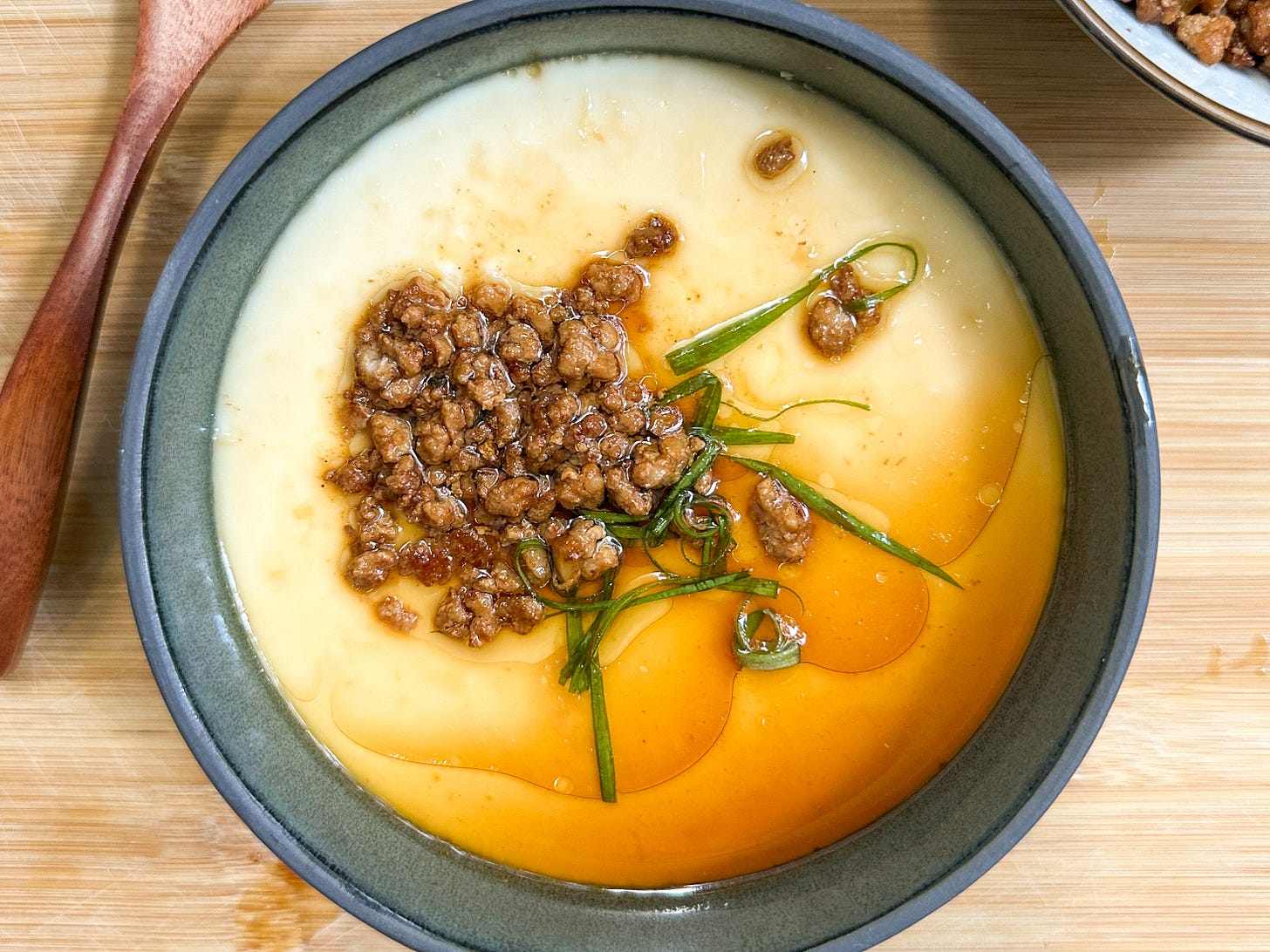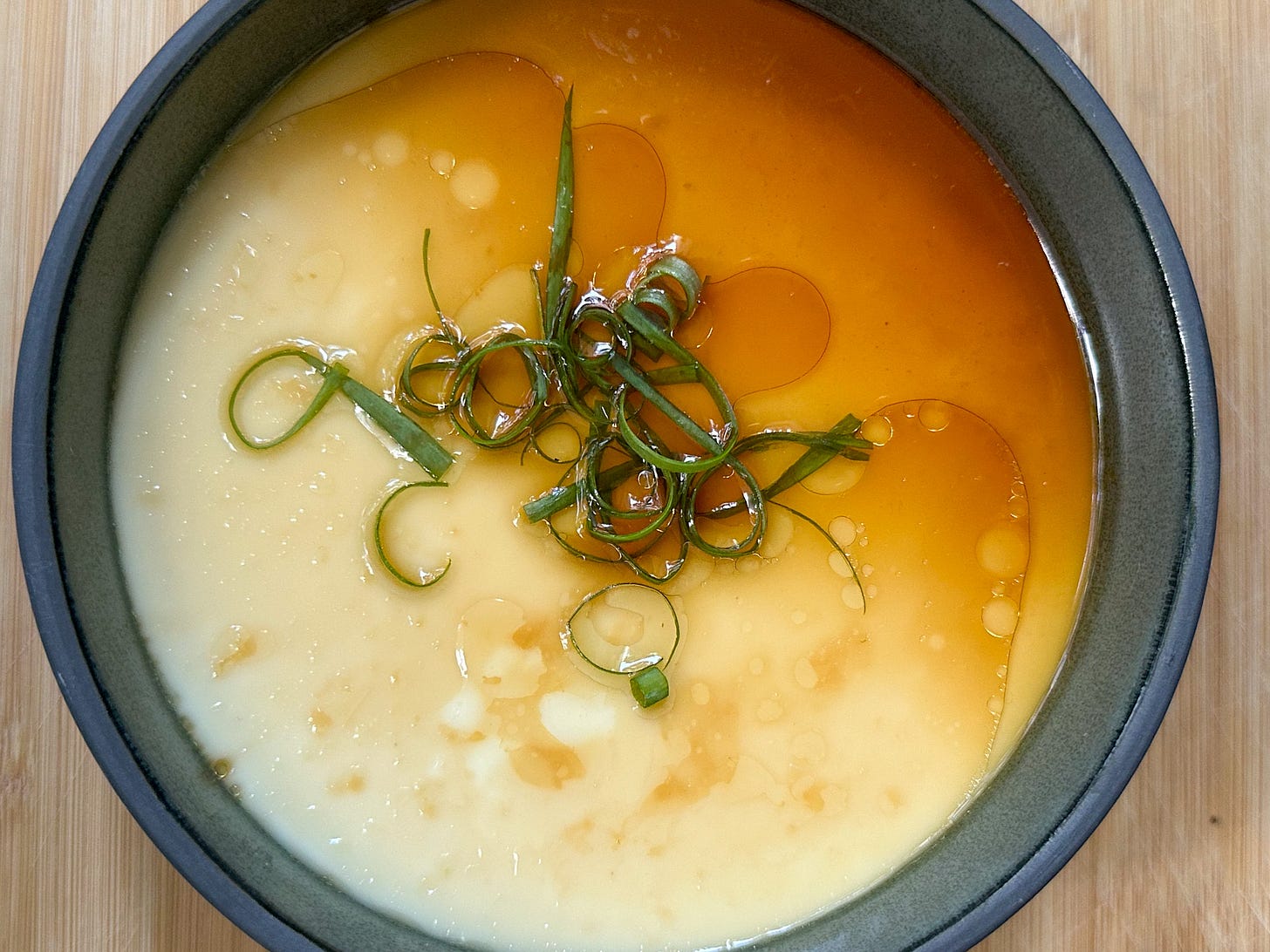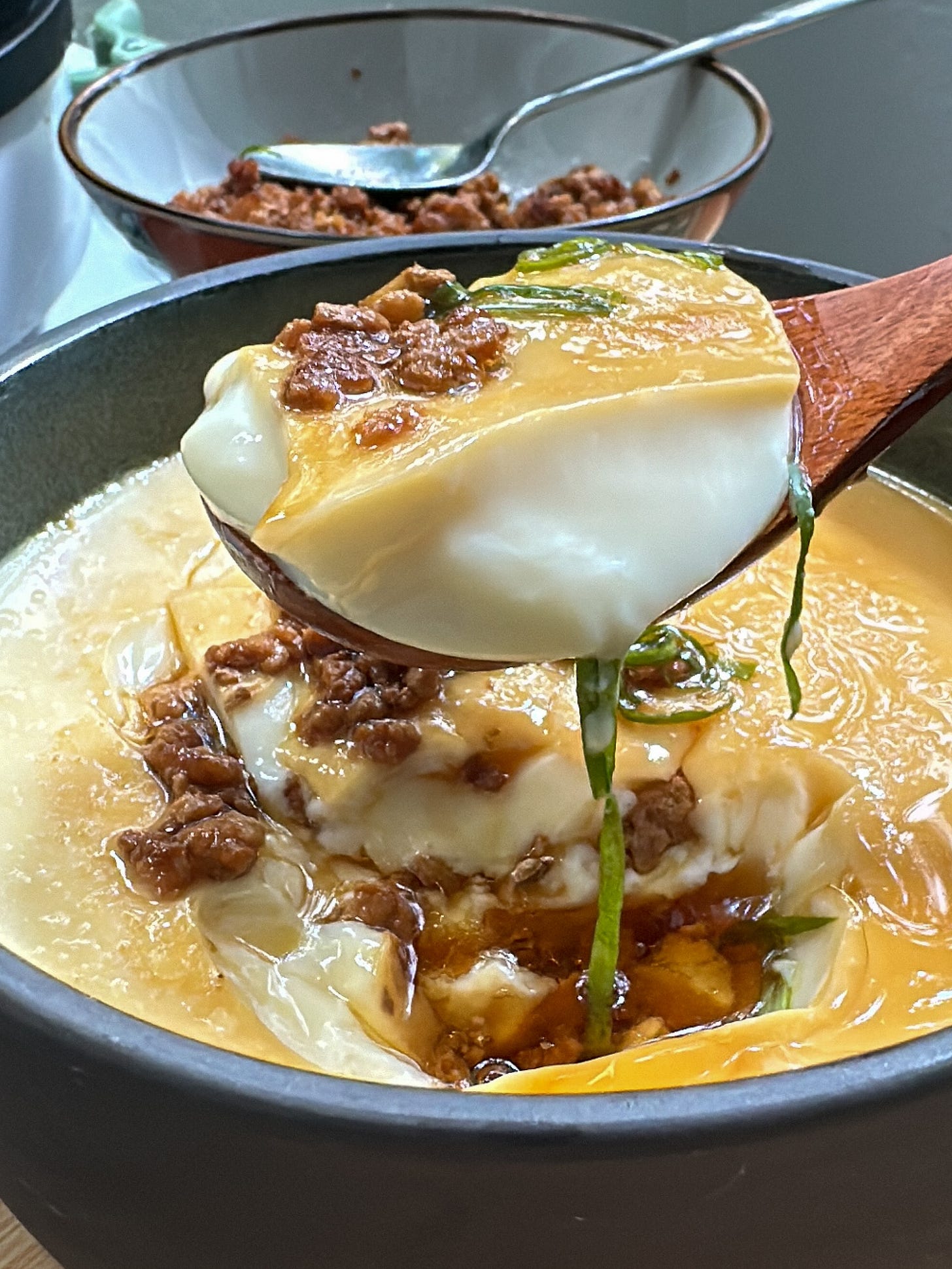Chinese Steamed Eggs (Zheng Dan)
Sometimes a bowl of jiggly, wobbly egg custard is all I want.
Hi, Happy Monday! Unusual posting day but I’m sharing an egg recipe that’s perfect for weekdays. Eggs are something that I eat a lot off camera—scrambled with tomato, fried over a pad kra pao, soft-boiled in Shin Ramyun—but this is one of the best and most nostalgic ways to enjoy them.
When I recently came back from a trip with an empty fridge, I caught myself snacking on sliced apples with peanut butter. I found it a bit amusing because I've somewhat integrated into a healthy snack culture that I didn't grow up with, probably thanks to all those Emily Mariko videos I’ve mindlessly scrolled through.
Although a plate of fresh-cut fruit (sans PB) would always be encouraged to eat, we didn’t have granola bars or banana bread. By my grandma, waipo’s definition, it could also be a bowl of simple steamed egg—zheng dan. During my last year of high school, we rented a small flat near my boarding school so that my retired grandma could take care of me: better sleep and food for better exam results. Every day when I got back late at night after our evening study session, she always served me an extra meal, what we call yexiao (夜宵) in Chinese: sometimes a small bowl of wontons or noodles, but most often, a quick steamed egg with some pork lard and soy sauce. I liked using the edge of a spoon to cut the egg open and watch the sauce seep into the cracks, a therapeutic and tasty moment that revived me after a draining day of studying.
Steamed egg goes by different names in Chinese, such as zheng dan (蒸蛋), dun dan (炖蛋), or zheng shui dan (蒸水蛋), depending on where you’re from. The variations extend to fluffy Korean gyeran-jjim in a clay pot and Japanese chawanmushi served in a tiny teacup. Every family has their own recipe. My waipo’s version was always pretty casual, and to feed a hungry teenager like me, it was always "better done than perfect."
Despite being a home-cooking classic, you’ll also find steamed eggs in restaurants. Last winter, I went on a noodle food tour in Yibin, Sichuan, the hometown of spicy burning noodles (ran mian). Among the countless choices of noodles, one dish caught my eye on the menu: saozi zhengdan (臊子蒸蛋), steamed egg topped with braised pork mince. This classic Sichuan side dish was the perfect balance to the fiery noodles. I was instantly reminded that I needed to make it in Berlin.
This is a recipe that, on one hand, tolerates tweaks and imperfections (as long as your egg is cooked), but on the other hand, it takes some practice to perfect if you’re looking for a flawless, pudding-like result. Scroll down to see some tips!
Recipe for Chinese Steamed Eggs
Serving: 1
Ingredients
2 medium-sized eggs (weighs about 100g)
200g / 1 cup warm water
1/8 tsp salt
1/4 tsp chicken bouillon powder (optional)
Topping and Seasoning:
1 tbsp soy sauce
1 tsp sesame oil
chopped scallion
1 tsp chili oil (optional)
2 tbsp minced pork sauce (optional, find the recipe here)
Instructions:
Crack two eggs into a mixing bowl, add lukewarm or warm water (at 40ºC-60ºC) slowly while stirring with a whisk or a pair of chopsticks. Season with salt and chicken powder, then mix well. Strain the mixture through a fine sieve into a heatproof bowl, and use a spoon to remove any bubbles on the surface.
Bring a pot of water to a gentle boil, set up the steamer, and add your bowl of egg mixture. Cover and let it steam over low heat for 10-12 minutes, until the egg mixture sets. Turn off the heat, and let it sit for about 5 minutes to finish cooking with the residual heat.
Remove the bowl carefully with a towel or plate gripper clamp, then season with your preferred topping. Serve it with rice or with noodles as a side dish.
Tips for Making Perfect Chinese Steamed Eggs
I've been referencing some interesting guides I saw on Chinese social media and did multiple tests myself. The (seemingly) scientific explanation for creating a smooth egg custard is to avoid aggressive heat convection from the steam to the egg mixture, hence the need for gentle heat. (If you have a better explanation, let me know!)
Egg-to-liquid ratio:
1:1.5 to 1:2 in weight (for 100g egg, use 150g-200g water), depending on the consistency you like. A 1.5 times liquid ratio results in a firmer texture, while 2 times gives a softer one. I usually opt for the latter. Measuring by weight is easier for me; 2 medium-sized eggs weigh about 100-110g, so you can add around 200g / 200ml of water.
Liquid temperature:
Lukewarm or warm water (40-60°C / 100-140°F) works best for me. I use a barista kettle that can control the temperature, but if you don’t have one, just use water that’s warm to the touch but not hot.
Sieve the egg mixture:
Sieving out the bubbles and chunky bits from the egg mixture results in a smooth texture. I usually run it through a fine sieve and scoop out any small bubbles around the edges of the bowl.
Heat:
Once the water is simmering, use gentle, low heat to steam the egg. On my electric and induction stove, I use only a setting of 2-3 of 10.
Some also advise covering the bowl with a plate or using plastic wrap with a few holes poked in it. For my bamboo steamers, I’ve tried with and without cover, and it didn’t make much of a difference. If you’re using a pot with a lid, try covering the steaming bowl with a plate to prevent water droplets from dripping onto the egg's surface.
You can also top the eggs with shrimp, okra, or even clams!
Use microwave instead of steamer (updated):
After posting this video on Instagram, I received many comments suggesting that this dish can easily be made in the microwave. Curious to try it, I followed the settings from Eric Kim’s recipe on NYT Cooking. In my microwave (800w), it takes a little less power and time, as I prefer the dish to be on the softer, more tender side.
If you want to use a microwave, replace step 2 and 3 to the following:
Cover with a microwave-safe plate and microwave for 4–5 minutes at 50% power (400w). Check at 4 minutes (use a towel or oven mitts to uncover and be careful of the steam) to see if the mixture is mostly set. If it’s still runny, add 1 minute at a time. Let it sit, covered, for 2–3 minutes until fully set (let the residual heat to cook the eggs further but keep it smooth). Top with your sauce of choice.









Ohh classic comfort food - we had 蒸水蛋 at least 2-3 times a week when we were kids. And we still make it regularly, or whenever we want something warm and comforting. Sometimes we add pork mince to the base, sometimes we just sprinkle with scallions and ladle sizzling oil on top.
Yours looks so luscious, we're making it the next chance we get, thanks!
I am definitely going to try these. Keep seeing them all over and I wanna try x